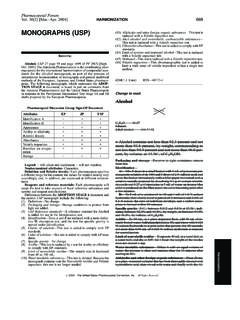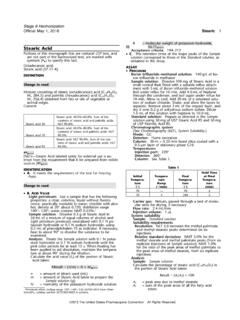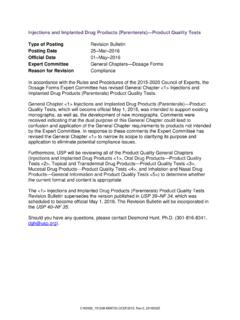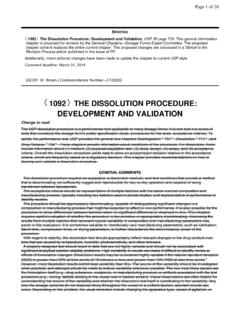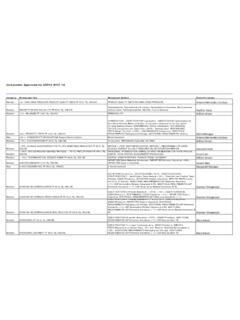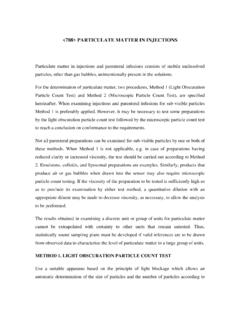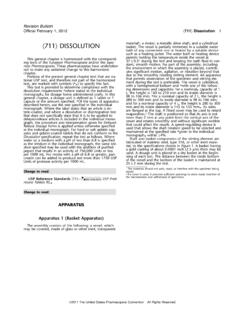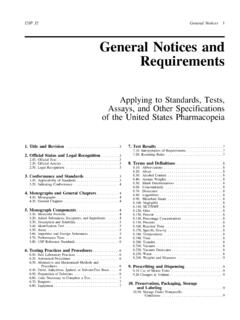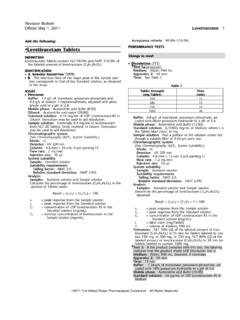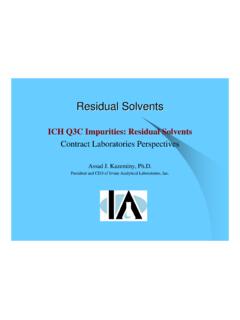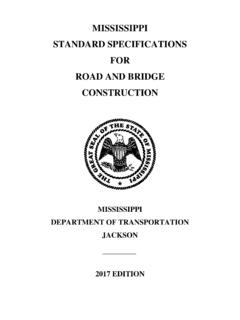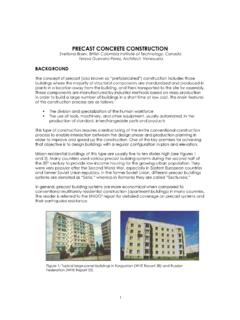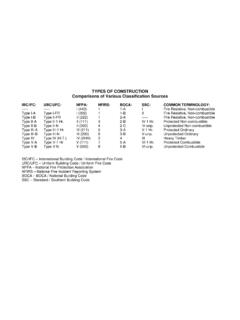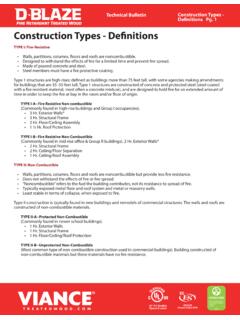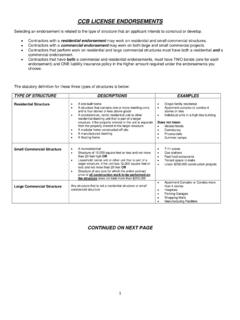Transcription of 661.1 Plastic Materials of Construction Type of Posting ...
1 < > Plastic Materials of Construction Type of Posting Revision Bulletin Posting Date 26-Feb-2021 Official Date 1-Mar-2021 Expert Committee General Chapters - Packaging and DistributionIn accordance with the Rules and Procedures of the Council of Experts, the General Chapters - Packaging and Distribution Expert Committee has revised General Chapter < > Plastic Materials of Construction . The purpose for the revision is to address comments received regarding Solution S1 for polyamide 6, polyvinyl chloride, and polyvinyl chloride plasticized, and the equation for the determination of Chlorine content in polyvinyl chloride. In addition, footnote a under Table 1 is corrected to refer to Plastic additives tests.
2 The < > Plastic Materials of Construction Revision Bulletin supersedes the currently official general chapter. Should you have any questions, please contact Desmond G. Hunt ( 301-816-8341 or C296560-M8008-GCPD2020, rev 00 20210226 Revision Bulletin Official: March 1, 2021 Change to read: Plastic Materials OF Construction (This chapter will become official on December 1, 2025. Early adoption of the requirements inthis chapter and its companion chapter Plastic Packaging Systems for Pharmaceutical Use are permitted by USP. When early adoption is not used, Plastic Packaging Systems andTheir Materials of Construction 661 will apply. If or are referenced elsewhere inthe USP-NF prior to December 1, 2025, the standards in 661 will apply if early adoption of or has not occurred.))
3 INTRODUCTIONSCOPECYCLIC OLEFINSPOLYAMIDE 6 POLYCARBONATEPOLYETHYLENEPOLYETHYLENE TEREPHTHALATE AND POLYETHYLENE TEREPHTHALATE GPOLY(ETHYLENE-VINYL ACETATE)POLYPROPYLENEPOLYVINYL CHLORIDEPOLYVINYL CHLORIDE, PLASTICIZEDINTRODUCTIONThe use of well-characterized Materials to construct packaging systems is a primary means of ensuringthat the packaging system is suited for its intended use. Materials are characterized so that theirproperties and characteristics can be matched to the performance requirements of the packaging system,thus facilitating the intentional selection of appropriate Materials . For the purposes of this chapter, aplastic material of Construction is considered to be well characterized for its intended use if the followingcharacteristics have been adequately established: its identity, biological reactivity, generalphysicochemical properties, and composition ( , additives likely to be present).
4 Extractable elementsmay also be relevant to the selection of a packaging system s Materials of Construction and therefore arelevant aspect of material characterization. Materials of Construction can vary widely in terms of theirintentionally and unintentionally added elements and their potential use. Because of this, it is challengingto provide universally effective and efficient tests methodologies, lists of target elements and reportingrequirements. It is the material user s responsibility to evaluate the need for extractable elements testingand, if such testing is necessary, to establish and justify the means by which testing is accomplished,taking into account extraction conditions, target elements, and reporting purpose of this chapter is to provide test methods for determining the suitability of plasticmaterials of Construction used in packaging systems for drug products.
5 Individual Plastic Materials ofconstruction are considered to be well characterized if they meet the requirements in this chapter or areused in a packaging system that meets the requirements in Plastic Packaging Systems for PharmaceuticalUse . The testing and qualification of Plastic packaging systems and components forpharmaceutical use are covered in .This chapter contains tests, methods, and acceptance criteria for the following Materials : cyclic olefins;polyamide 6; polycarbonate; polyethylene; polyethylene terephthalate; polyethylene terephthalate G;C296560-M8008-GCPD2020, rev 00 20210226poly(ethylene-vinyl acetate); polypropylene; polyvinyl chloride; and polyvinyl chloride, packaging systems could be constructed from Materials that are not specifically addressed inthis chapter; such Materials of Construction are termed "unaddressed Materials ".
6 For an unaddressedmaterial to be considered compliant with this chapter, it must be characterized and meet acceptancecriteria established in ways that are comparable to those used for the Materials specified in this , the unaddressed material of Construction must be identified by appropriate methodology andbe tested with consideration of the dosage forms for which it is used ( , biological reactivity,physicochemical properties, and Plastic additives; see 1661 ).Table 1 Table 1 provides the appropriate application of the chemical and biological 1. Application of TestsTest ParameterOral and TopicalDosage FormsaAll Other DosageFormsIdentificationXXPhysicochemic alUV absorbanceXXAcidity/alkalinityXXTotal organic carbon (TOC)XXExtractable elements b bPlastic additives cXBiological ReactivityIn vitro per Biological ReactivityTests, In Vitro 87 d Xa For aqueous-based oral drug products that contain cosolvents (or if, for any reason, it may be expected to extract greateramounts of substances from Plastic packaging components than water), additional extractables information may be needed todetermine suitability.
7 If additional information is required, perform Plastic additives (RB 1-Mar-2021) tests as directed in this As deemed necessary and appropriate by end-user. See 1661 for additional Provide appropriate reference to the Indirect Food Additive regulations in 21 CFR 174 186, specifically those addressing thepurity criteria and limitations pertaining to Biological reactivity testing in support of Plastic packaging Materials used for final pharmaceutical product packaging/deliverysystems (drugs and drug/device combination products) provides baseline information and will often not be sufficient to assess thefinal suitability for use expectations of regulatory authorities.
8 Thus, it is important to work with the appropriate regulatory authorityfor guidance regarding a product specific OLEFINSI dentification A. I S Refer to Mid-Infrared Spectroscopy 854 .Apparatus:Use an infrared spectrophotometer capable of correcting for the blank spectrum and able tomeasure in transmission mode or equipped with an internal reflectance accessory and an appropriateinternal reflectance preparationTransmission mode:Prepare a specimen of appropriate thickness without visible defects (cracks orholes). The specimens can be compressed to form a thin, uniform film by exposure to elevatedtemperatures and pressures (2000 psi or more). The temperatures at which the thin films areC296560-M8008-GCPD2020, rev 00 20210226generated represent a trade-off between producing a melt (which dictates the lowest temperaturenecessary) and degrading the sample (which dictates the highest temperature allowed).
9 Ultimately,the temperatures that are used are appropriate if the film produced is conducive to the reflectance mode:Prepare a flat section and trim it as necessary to obtain a segment that isconvenient for mounting in the internal reflectance accessory. Taking care to avoid scratching thesurfaces, wipe the specimen with dry paper or, if necessary, a soft cloth dampened with methanol, andpermit the surfaces to dry. Then securely mount the specimen on the internal reflection plate,ensuring adequate surface :Place the mounted specimen sections in the sample compartment of the infraredspectrophotometer or the internal reflectance accessory, and place the assembly in the specimen beamof the infrared spectrophotometer.
10 For internal reflectance, adjust the specimen position and mirrorswithin the accessory to permit maximum light transmission of the unattenuated reference beam. (For adouble-beam instrument, attenuate the reference beam after completing the adjustment in theaccessory to permit full-scale deflection during the scanning of the specimen.) Determine the infraredspectrum from 3800 cm 1 to 650 cm 1 ( 15 m).Acceptance criteria:The specimen exhibits an absorption spectrum that is substantially equivalent tothat of USP Cyclic Olefin Polymer RS or USP Cyclic Olefin Copolymer RS. Substantial, as opposed toexact, equivalence allows for minor spectral differences arising from the natural compositional and/orphysical variation among polymers of this class.
